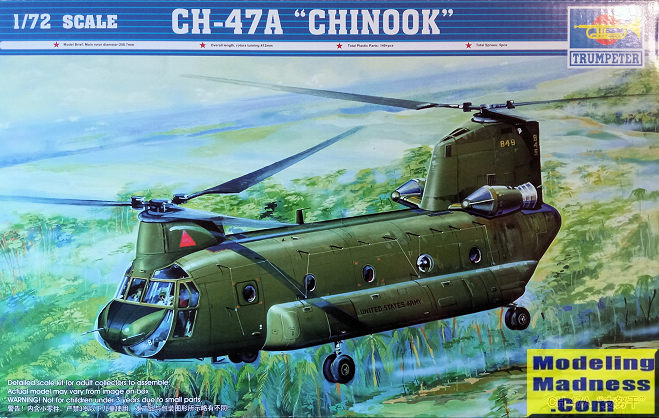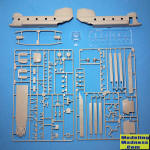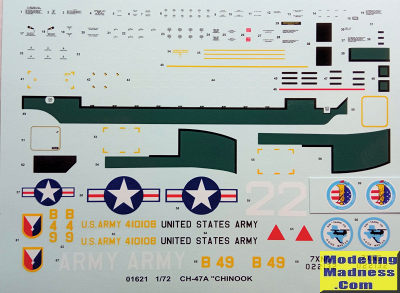
| KIT #: | 01621 |
| PRICE: | Around €25 |
| DECALS: | Three options |
| REVIEWER: | Spiros Pendedekas |
| NOTES: | 2008 tooling |

| HISTORY |
The CH-47 Chinook is a tandem rotor heavy-lift helicopter manufactured by Boeing Vertol. It possesses several means of loading various cargoes, including multiple doors across the fuselage, a wide loading ramp located at the rear of the fuselage and a total of three external ventral cargo hooks to carry underslung loads. It is still one of the fastest helicopters in the US inventory, with improved and more powerful versions also developed since its introduction in 1961. It remains one of the few aircraft introduced during the early 1960s that has remained in both production and frontline service for over 50 years. Over 1200 have been built.
| THE KIT |
 Trumpeter
came in 2008 with a new tool 1/72 Chinook, offered in both the “A” and the
improved “D” version (the latter previewed by our Editor here),
which basically share the same sprues but one that caters for the different
engines. The subject “A” version comes in a very nice and strong top opening box
with an attractive box art of a U.S. Army Aviation Chinook, flying over a
presumably Far East landscape.
Trumpeter
came in 2008 with a new tool 1/72 Chinook, offered in both the “A” and the
improved “D” version (the latter previewed by our Editor here),
which basically share the same sprues but one that caters for the different
engines. The subject “A” version comes in a very nice and strong top opening box
with an attractive box art of a U.S. Army Aviation Chinook, flying over a
presumably Far East landscape.
Upon opening the box, the first thing that struck
me was the superb packaging, something that Trumpeter has become famous for,
among others. All parts are separately bagged, with additional pieces of
cardboard compartmentalizing them in a supreme way. Well done Trumpeter!
I was greeted with 99 light gray styrene parts arranged in two sprues, except
for the two engine covers that are in a mini sprue and the fuselage halves that
are separate pieces. Molding is first class, with crisp recessed panel lines but
also raised details where required. No flash was apparent whatsoever.
The highly visible cockpit is sufficiently detailed with all basic controls. The
instrument panel and console faces are nicely provided as separate thin plates
with fine raised detail. They will look great with dry brushing and some
red/yellow/white “knobs” added with a fine brush. Seats also look good with
molded-on seat belts. Apart from the front bulkhead, the good looking floor and
the structurally detailed sidewalls, no other cargo detailing is provided. The
rear ramp and side entry hatch are separate, so if you wish to pose them open
you might consider beefing up the empty cargo area.
The engines are well represented, something also very true for the rotors, which
feature convincing hubs and blades superbly molded “dropped”, which is their
posture on the ground with engines stopped. The landing gear is well
represented, as are the various add-ons (antennas, hooks and the like) that are
found all over the Chinook!
Two clear sprues are provided, one containing the one piece canopy and another
containing all windows. They are superbly molded and crystal clear. Instructions
are very well done in a mini booklet style, containing a parts list, with the
construction sequence spread in nine logical and clear steps. Internal color
callouts are provided in Gunze, Mr Color but also generic names.
 The decal
sheet looks sharply printed and of good quality. Colors look very good, too,
though a number of modelers might find them tad on the bright side. A small
correction sheet is supplied for one US Army badge that was not correctly
depicted on the main sheet.Three schemes are provided, two US Army Aviation and
one Texas NG. They are all done in olive drab allover, with the one of the US
Army schemes featuring some orange at both the nose and tail and a yellow band
surrounding the fuselage, in front of the engines. This might be the most
interesting of the three, offering some color note on an otherwise “bland” olive
drab scheme!
The decal
sheet looks sharply printed and of good quality. Colors look very good, too,
though a number of modelers might find them tad on the bright side. A small
correction sheet is supplied for one US Army badge that was not correctly
depicted on the main sheet.Three schemes are provided, two US Army Aviation and
one Texas NG. They are all done in olive drab allover, with the one of the US
Army schemes featuring some orange at both the nose and tail and a yellow band
surrounding the fuselage, in front of the engines. This might be the most
interesting of the three, offering some color note on an otherwise “bland” olive
drab scheme!
Instructions start with cockpit assembly onto the big floor, then attaching the
2-piece bulkhead that separates the cockpit from the cargo area. The side
windows are then attached from the insides, followed by the lower side walls,
with the assembled cockpit/cargo floor and the rotor bases trapped between the
fuselage halves. The engines are next assembled and attached, followed by the
side entry hatch. Then the landing gear and various antennas, hooks and the like
are to be affixed (I would leave these “delicacies” off, to attach at later
stages…). The rear ramp is next, followed by canopy attachment. Assembly and
attachment of the rotors are the final steps of what looks to be a build of
average complexity.
| CONCLUSIONS |
This looks to be a superb kit of the highly iconic
Chinook. General shape looks good, as does all external detailing. Cockpit as
well as the rest of the details are more than sufficient for the scale, with the
rotors superbly depicted “drooped”. Molding is excellent and transparencies are
very well done. Decals look good and instructions are clear. The only minor
complaint concerns the structurally correctly depicted but otherwise empty cargo
area, which may be beefed up with aftermarket stuff that seems to be available,
should you wish to pose the rear ramp and/or side entry hatch open.
With a price that seems right for what the kit offers and seemingly good
availability, looks like we have a winner here!
March 2022
Copyright ModelingMadness.com. All rights reserved. No reproduction in part or in whole without express permission.
If you would like your product reviewed fairly and fairly quickly, please contact the editor or see other details in the Note to Contributors.